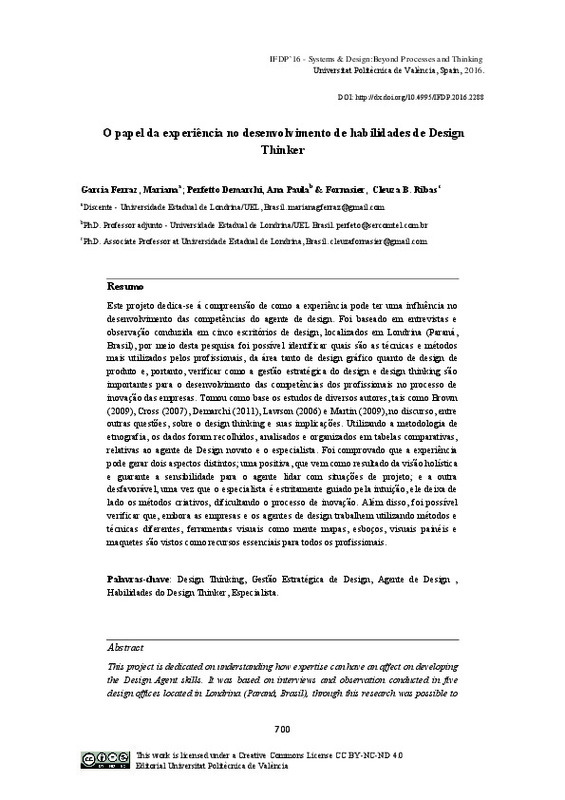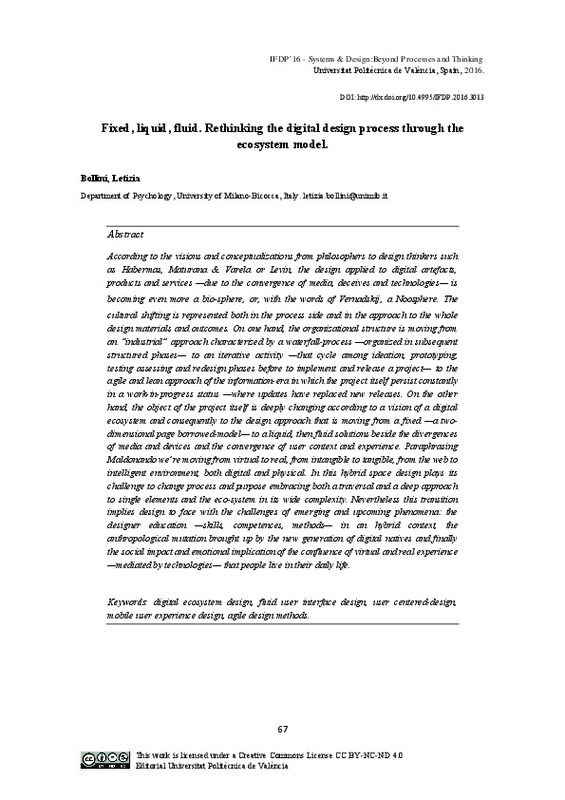JavaScript is disabled for your browser. Some features of this site may not work without it.
Buscar en RiuNet
Listar
Mi cuenta
Estadísticas
Ayuda RiuNet
Admin. UPV
Comparison of the degree of creativity in the design outcomes using different design methods
Mostrar el registro sencillo del ítem
Ficheros en el ítem
| dc.contributor.author | Chulvi Ramos, Vicente
|
es_ES |
| dc.contributor.author | Mulet Escrig, Elena
|
es_ES |
| dc.contributor.author | Chakrabarti, A.
|
es_ES |
| dc.contributor.author | López-Mesa, Belinda
|
es_ES |
| dc.contributor.author | González-Cruz, María-Carmen
|
es_ES |
| dc.date.accessioned | 2020-03-16T14:46:44Z | |
| dc.date.available | 2020-03-16T14:46:44Z | |
| dc.date.issued | 2012 | es_ES |
| dc.identifier.issn | 0954-4828 | es_ES |
| dc.identifier.uri | http://hdl.handle.net/10251/138956 | |
| dc.description.abstract | [EN] This work analyses the influence of several design methods on the degree of creativity of the design outcome. A design experiment has been carried out in which the participants were divided into four teams of three members, and each team was asked to work applying different design methods. The selected methods were Brainstorming, Functional Analysis, and SCAMPER method. The 'degree of creativity' of each design outcome is assessed by means of a questionnaire offered to a number of experts and by means of three different metrics: the metric of Moss, the metric of Sarkar and Chakrabarti, and the evaluation of innovative potential. The three metrics share the property of measuring the creativity as a combination of the degree of novelty and the degree of usefulness. The results show that Brainstorming provides more creative outcomes than when no method is applied, while this is not proved for SCAMPER and Functional Analysis. © 2012 Copyright Taylor and Francis Group, LLC. | es_ES |
| dc.description.sponsorship | The present research has been partially funded by the Fundacio Caixa Castello - Bancaixa (P1.1B2010-51). | es_ES |
| dc.language | Inglés | es_ES |
| dc.publisher | Taylor & Francis | es_ES |
| dc.relation.ispartof | Journal of Engineering Design | es_ES |
| dc.rights | Reserva de todos los derechos | es_ES |
| dc.subject | Creativity | es_ES |
| dc.subject | Design methods | es_ES |
| dc.subject | Novelty and usefulness | es_ES |
| dc.subject | Design method | es_ES |
| dc.subject | Work analysis | es_ES |
| dc.subject | Functional analysis | es_ES |
| dc.subject | Problem solving | es_ES |
| dc.subject | Design | es_ES |
| dc.subject.classification | PROYECTOS DE INGENIERIA | es_ES |
| dc.title | Comparison of the degree of creativity in the design outcomes using different design methods | es_ES |
| dc.type | Artículo | es_ES |
| dc.identifier.doi | 10.1080/09544828.2011.624501 | es_ES |
| dc.relation.projectID | info:eu-repo/grantAgreement/UJI//P1·1B2010-51/ | es_ES |
| dc.rights.accessRights | Cerrado | es_ES |
| dc.contributor.affiliation | Universitat Politècnica de València. Departamento de Proyectos de Ingeniería - Departament de Projectes d'Enginyeria | es_ES |
| dc.description.bibliographicCitation | Chulvi Ramos, V.; Mulet Escrig, E.; Chakrabarti, A.; López-Mesa, B.; González-Cruz, M. (2012). Comparison of the degree of creativity in the design outcomes using different design methods. Journal of Engineering Design. 23(4):241-269. https://doi.org/10.1080/09544828.2011.624501 | es_ES |
| dc.description.accrualMethod | S | es_ES |
| dc.relation.publisherversion | https://doi.org/10.1080/09544828.2011.624501 | es_ES |
| dc.description.upvformatpinicio | 241 | es_ES |
| dc.description.upvformatpfin | 269 | es_ES |
| dc.type.version | info:eu-repo/semantics/publishedVersion | es_ES |
| dc.description.volume | 23 | es_ES |
| dc.description.issue | 4 | es_ES |
| dc.relation.pasarela | S\230539 | es_ES |
| dc.contributor.funder | Fundació Caixa Castelló - Bancaixa | es_ES |
| dc.contributor.funder | Universitat Jaume I | es_ES |
| dc.description.references | Alves, J., Marques, M. J., Saur, I., & Marques, P. (2007). Creativity and Innovation through Multidisciplinary and Multisectoral Cooperation. Creativity and Innovation Management, 16(1), 27-34. doi:10.1111/j.1467-8691.2007.00417.x | es_ES |
| dc.description.references | Chakrabarti , A. Towards a measure for assessing creative influences of a creativity technique . International conference on engineering design, ICED 03 , Edited by: Folkeson , A. , Gralen , K. , Norell , M. and Sellgren , U. pp. 157 – 158 . Stockholm , Sweden. Scotland : The Design Society . | es_ES |
| dc.description.references | CHAKRABARTI, A., SARKAR, P., LEELAVATHAMMA, B., & NATARAJU, B. S. (2005). A functional representation for aiding biomimetic and artificial inspiration of new ideas. AI EDAM, 19(02). doi:10.1017/s0890060405050109 | es_ES |
| dc.description.references | Groger, I., Sander, W., & Wirth, W.-D. (1990). Experimental phased array radar ELRA with extended flexibility. IEEE Aerospace and Electronic Systems Magazine, 5(11), 26-30. doi:10.1109/62.63160 | es_ES |
| dc.description.references | GONZÁLEZ CRUZ, M. C., AGUILAR ZAMBRANO, J. A., AGUILAR ZAMBRANO, J. J., & GARDONI, M. (2008). LA ESTRATEGIA DE CREATIVIDAD SISTEMÁTICA TRIZ CON EQUIPOS MULTIDISCIPLINARES DE DISEÑO DE PRODUCTO. DYNA INGENIERIA E INDUSTRIA, 83(1), 337-352. doi:10.6036/1937 | es_ES |
| dc.description.references | López-Mesa, B., Mulet, E., Vidal, R., & Thompson, G. (2009). Effects of additional stimuli on idea-finding in design teams. Journal of Engineering Design, 22(1), 31-54. doi:10.1080/09544820902911366 | es_ES |
| dc.description.references | Mulet , E. and Vidal , R. Classification and effectiveness of different creative methods in design problems . 13 International conference on engineering design ICED'01 . August 21–23 , Glasgow . Townbridge, Wiltshire , UK : The Crombell Press . | es_ES |
| dc.description.references | Peeters, M. A. G., van Tuijl, H. F. J. M., Reymen, I. M. M. J., & Rutte, C. G. (2007). The development of a design behaviour questionnaire for multidisciplinary teams. Design Studies, 28(6), 623-643. doi:10.1016/j.destud.2007.06.004 | es_ES |
| dc.description.references | Sarkar , P. and Chakrabarti , A. Development of a method for assessing design creativity . International conference on engineering design (ICED07) . Paris , France | es_ES |
| dc.description.references | Schütze, M., Sachse, P., & Römer, A. (2003). Support value of sketching in the design process. Research in Engineering Design, 14(2), 89-97. doi:10.1007/s00163-002-0028-7 | es_ES |
| dc.description.references | Shah, J. J., Smith, S. M., & Vargas-Hernandez, N. (2003). Metrics for measuring ideation effectiveness. Design Studies, 24(2), 111-134. doi:10.1016/s0142-694x(02)00034-0 | es_ES |






![[Cerrado]](/themes/UPV/images/candado.png)



